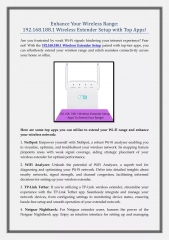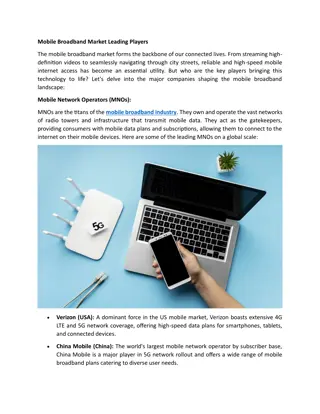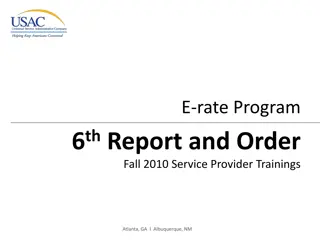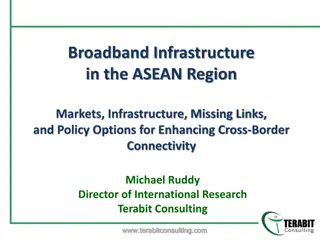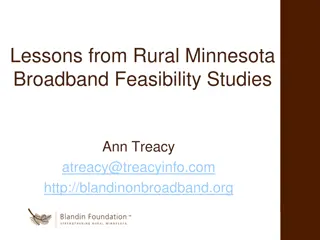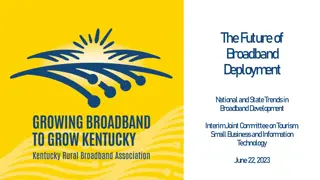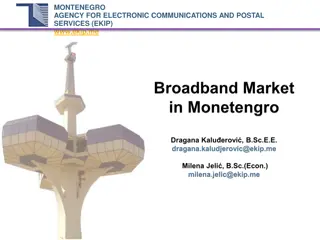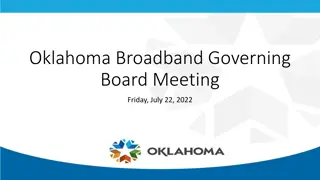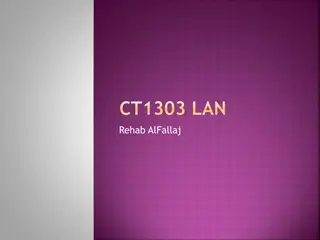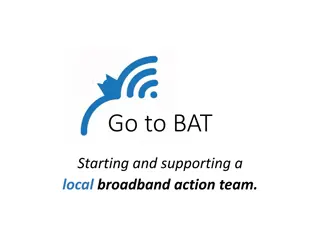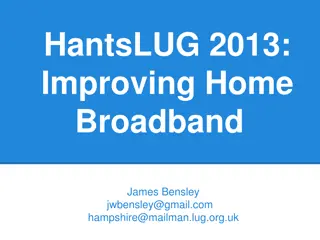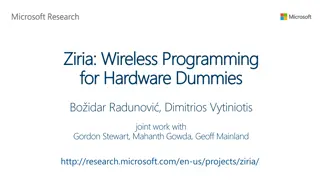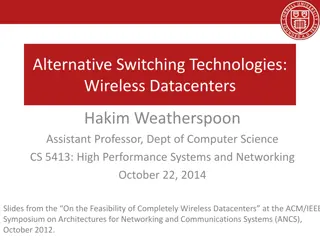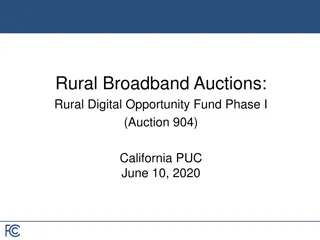Wireless Broadband Technologies Overview
Delve into the world of wireless broadband technologies with a focus on Mobile WiMAX based on IEEE 802.16e. Explore concepts like OFDM and OFDMA, subchannelization schemes, OBBP vs. MOBBP, simulation results, and more. Discover the implementation of the Orientation-Based Burst Packing algorithm and comparisons with other packing strategies. Gain insights into overlapping subcarriers, inter-symbol interference, and the use of subchannels in broadband wireless channels.
Download Presentation

Please find below an Image/Link to download the presentation.
The content on the website is provided AS IS for your information and personal use only. It may not be sold, licensed, or shared on other websites without obtaining consent from the author. Download presentation by click this link. If you encounter any issues during the download, it is possible that the publisher has removed the file from their server.
E N D
Presentation Transcript
GHAZAL ROUHAFZAY SUPERVISED BY ASSOC. PROF. DR. ERHAN A. NCE
INTRODUCTION INTRODUCTION OFDM VS OFDMA Subchannelization schemes BROADBAND WIRELESS CHANNEL OBBP VS MOBBP SIMULATION RESULTS CONCLUSION & Future Works REFERENCES
Mobile WiMAX based on IEEE 802.16e is a broad band wireless access technology which has been widely accepted as the best solution for wireless broad band services. Instead of using a single wide-band carrier, multiple narrow-band parallel subcarriers are used OFDMA Subchannels
subchannels t The minimum frequency-time resource unit Slot Several slots assigned to a Mobile Station Burst IEEE802.16e Rectangular
Unused Slots 4 51 54 56 75
Implementing Orientation Based Burst Packing algorithm (OBBP) Introducing a new packing strategy in the third stage of the OBBP frame packing algorithm (Modified OBBP) Comparison Between OBBP MOBBP, eOCSA for randomly generated bursts Comparison Between OBBP MOBBP, eOCSA for Hata channel model
INTRODUCTION OFDM VS OFDMA OFDM VS OFDMA Subchannelization schemes BROADBAND WIRELESS CHANNEL OBBP VS MOBBP SIMULATION RESULTS CONCLUSION & Future Works REFERENCES
Overlapping subcarriers ????????? Saving in Bandwidth
User1 User2 User3 User4 Subchannels OFDM Symbol n+1 OFDM Symbol n OFDM Symbol n+2
ISI is a form of distortion of a signal in which one symbol interferes with subsequent symbols. ????????? OFDM Symbol OFDM Symbol OFDM Symbol OFDM Symbol ? Inter Symbol Interference (ISI)
1 OFDM Symbol = L data symbols ISI between OFDM symbols are removed While ??> ? T=L?? OFDM SYMBOL Duration Data SYMBOL Duration T ? ? OFDM Symbol OFDM Symbol Symbol OFDM OFDM Symbol OFDM Symbol OFDM Symbol Guard Interval ?? Guard Interval ??
Cyclic prefix OFDM DATA SYMBOLS COPY AND PASTE THE LAST V SYMBOLS
INTRODUCTION OFDM VS OFDMA Subchannelization schemes Subchannelization schemes BROADBAND WIRELESS CHANNEL OBBP VS MOBBP SIMULATION RESULTS CONCLUSION & Future Works REFERENCES
Data: Useful data transmission Pilot: Channel estimation & Synchronization Null: Guard Intervals & DC
FUSC Diversity (Distributed) (Full Usage of Subchannels) Downlink PUSC The subcarriers are distributed over the entire spectrum (Partial Usage of Subchannels) AMC (Adaptive Modulation and Coding) Contiguous (Adjacent) Subcarriers are from adjacent frequencies
2 symbol ?? ???????????=28 4 pilot &24 data subcarriers
1- Pilot subcarriers 48 data subcarriers Constant Variable
INTRODUCTION OFDM VS OFDMA Subchannelization schemes BROADBAND WIRELESS CHANNEL BROADBAND WIRELESS CHANNEL OBBP VS MOBBP SIMULATION RESULTS CONCLUSION & Future Works REFERENCES
Transmitter Communication System Receiver The variation of signal amplitude over frequency and time. Fading Shadowing Pathloss
Path loss means the reduction in power density of the signal as it passes through the wireless channel. Transmitter gain Receiver gain ?????? ???? Frii s formula ??= ?? Transmitted power, Received power at the receiver
Environments Path Loss Formulas PL= 46.3 +33.9 log10? 13.82 log10( ?) a ?+ Urban (44.9 6.55log10( ?)) log10?+ ?? a ?=3.2(log10(11.75 ?))2 4.79
INTRODUCTION OFDM VS OFDMA Subchannelization schemes BROADBAND WIRELESS CHANNEL OBBP VS MOBBP OBBP VS MOBBP SIMULATION RESULTS CONCLUSION & Future Works REFERENCES
Packing remaining bursts Pre-packing Pre-packing Stage Stage Main Packing Stage
Priority Sorting OF Constructing OF Matrix Burst Calculation Adaptation
? ? ????? = 60 14 = 840 B= ??,??, ,??, ?? ??+ ??+ ??+ + ??> ??????
Divisors = ? = 1,2,,?? | ? ? ,??? ?? ,? = 0 ? = 10,7,4,6,10,9,4,10 1 7 ,7 1 1 4 ,2 2 ,4 1 1 6 ,2 3,3 2 ,6 1 1 10 ,2 5 ,5 2,10 1 1 9 ,9 1
2 4 1 0 0 0 4 0 6 7 0 9 10 1 1 4 4 1 2 2 0 4 6 0 10 0 0 0 0 0 2 0 6 0 0 0 0 0 0 0 0 4 0 0 0 0 0 0 0 0 0 4 0 10 0 0 0 0 0 0 0 0 OF_Matrix= 6 0 0 0 0 0 0 0 0 0 7 0 0 0 0 0 0 0 0 0 0 0 0 0 0 0 0 0 0 0 9 0 0 0 0 0 0 0 0 0 10 0 0 0 0 0 0 0 0 0
Removing bursts with OFs out of the frame range from the OF_Matrix. DL DL- -Subframe Subframe 60 60 ?? ?? 80 80 = 1 80,2 40,4 20,5 16, 8 10,10 8,16 5,20 4, 80 1
?? = 1 67, 67 1 67 67 ?? 67 + 1 67 + 1 = ?? = 1 68, 2 34,4 17, 17 4,34 2,68 1
CONSTRUCTING CONSTRUCTING RP RP MATRIX MATRIX ? = 10,7,4,6,10,9,4,10 0 0 0 2 0 1 1 0 1 3 0 2 1 0 3 0 0 0 0 0 0 1 0 0 0 0 0 0 0 0 2 0 0 0 0 0 0 0 0 0 0 3 0 0 0 0 0 0 0 0 Rp_Matrix= 1 0 0 0 0 0 0 0 0 0 1 0 0 0 0 0 0 0 0 0 0 0 0 0 0 0 0 0 0 0 1 0 0 0 0 0 0 0 0 0 3 0 0 0 0 0 0 0 0 0
Packing remaining bursts Main Packing Pre-packing Stage Main Packing Stage Stage
Packing set selection Packing Set Arrangement Packing Set Stuffing
0 0 0 4 0 6 7 0 9 10 0 4 6 0 10 0 0 0 0 0 4+6+7+9+10=36 0 6 0 0 0 0 0 0 0 0 4 0 0 0 0 0 0 0 0 0 0 10 0 0 0 0 0 0 0 0 6 0 0 0 0 0 0 0 0 0 7 0 0 0 0 0 0 0 0 0 0 0 0 0 0 0 0 0 0 0 9 0 0 0 0 0 0 0 0 0 10 0 0 0 0 0 0 0 0 0 ?? ?? ? ? ?? ? ? ? ? ??
???? = {4, 6, 14, 18, 24, 32, 44, 50, 74, 76, 78} ???? = {78, 76, 74, 50, 44, 32, 24, 18, 14, 6, 4} ? ?max_? = 39,38,37,25,22,16,12,7,3,2
Finding the optimal subset of bursts ????_? = ??,??,??,??,??,??,??,?,?,? 60 All elements in OF_Matrix with the values equal to 38 and 22 will be set to zero. {38, 22} 60 {37, 16, 7} 60 {39, 12, 7, 2} If the corresponding element in Rp Matrix is equal to 1 Else corresponding element in Rp Matrix will be reduced by 1
Calculating sum of each group Rearranging them in descending order based on their sums.
We start packing bursts from the bottom-right corner of the subframe.
Packing remaining Packing remaining bursts bursts Pre-packing Stage Main Packing Stage
Sorting remaining bursts in descending order Dividing unallocated slots into rectangles with its maximum possible dimension. Choosing the suitable rectangle for the burst Fitting the burst in the selected rectangle.
?? ? ??,? ??,?? ?,?? ? 1 ?? 7 ? ?? ? 40 ? 60 ? ????????? ?????????? OBBP algorithm drops the burst MOBBP ?? + ? = ?? ? ??,? ??,? ??,? ??,? ??,?? ?,?? ?,?? ?
INTRODUCTION OFDM VS OFDMA Subchannelization schemes BROADBAND WIRELESS CHANNEL OBBP VS MOBBP SIMULATION RESULTS SIMULATION RESULTS CONCLUSION & Future Works REFERENCES
[77 63 21] DL Subframe 10 20 Subchannels 30 40 50 60 2 4 6 8 10 12 14 Symbols Slots
[77 63 21] 78 64



